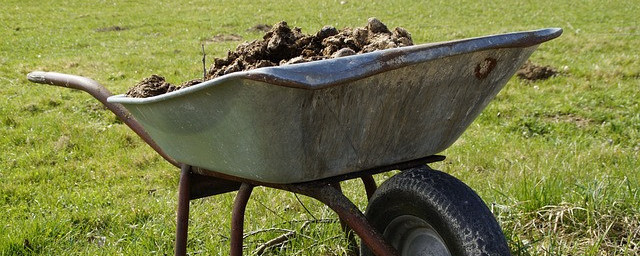Chicken manure is a combination of chicken droppings, bedding, and other debris found in a chicken coop. Being very “hot”, it is a good idea to learn how to use chicken manure wisely. Chicken manure can be used in solid and liquid form and both are loaded with the big three nutrients, N(itrogen), P(hosphorus), and K(otassium, uh, potassium I mean).
NPK is the ratio that you see on the front of fertilizer bags. Like, a 5-10-5 is 5% nitrogen, 10% phosphorus, and 5% potassium. That is not the point of this writing, but it’s nice to know, right?
Nitrogen is good for nice, green leaves, so I like to think of it as “nicetrogen”. Phosphorus is good for roots, seeds, blossoms, and fruit, so I like to think of it as “Fruitphorus”. Potassium is good for making plants strong with hearty stems, etc., so I like to think of potassium as having a lot of a_ _ to it. Now, just try to forget what each nutrient does. You can thank me next time you run into me.
I digress…
What Do You Mean By Hot?
Fresh chicken manure is referred to as “hot,” because it is high in NPK, and other nutrient content, and the quick release of same is too much for most plants in your garden to handle. The hotness isn’t physical heat, but more of a chemical burn. The result of this “burning ” is the demise of your plants.
Compost and Tea.
To reduce the “heat” in your chicken manure, there are a couple of maneuvers you can perform. You can make your own compost out of it, using a 2:1 ratio of two parts brown material such as leaves, hay, or wood shavings, and one part green material – that would be your chicken poop.
Your compost needs to work for a couple of months, or until it resembles dirt. It could take longer depending on the size of your compost pile.
The other way to cool down your chicken manure is to make a “tea” out of it. You do this by filling a barrel, 55-gallon drum, 20-gallon drum, or 5-gallon bucket, it really doesn’t matter, with your 2:1 mix, and cover it with water. Fill it to the top. Stir it up a little, then cover it and let it sit for a couple of weeks, stirring occasionally. Cover it loosely so gases can escape.
Hot Tip! Find some leaf mold in the woods by removing the dry top layer of leaves to find moist leaves with leaf mold underneath. Put these in your tea to really get things working!

After a couple of weeks, dip a small amount of your tea into a watering can to dilute even further to a 300:1 ratio. That is not a typo — 300:1 is where you want to start. This tea is super hot, so dilution is the solution to happy plants.
Water at will.
Nutrient Content of Chicken Manure
Poultry manure contains all 13 of the essential plant nutrients that are used by plants. These include nitrogen(N), phosphorous (P), potassium (K), calcium (Ca), magnesium (Mg), sulfur(S), manganese (Mn), copper (Cu), zinc (Zn), chlorine (Cl), boron (B), iron (Fe), and molybdenum (Mo).
| Element/Nutrient | % Content |
| Nitrogen (N) | 2.5 – 3.5 |
| Phosphorus (P) | 1.5 – 2.5 |
| Potassium (K) | 1.0 – 1.5 |
| Calcium (Ca) | 1.0 -1.5 |
| Magnesium (Mg) | 0.3 – 0.5 |
| Sulfur (S) | 0.2 – 0.3 |
| Iron (Fe) | 0.01 – 0.02 |
| Manganese (Mn) | 0.005 – 0.01 |
| Zinc (Zn) | 0.003 – 0.005 |
| Copper (Cu) | 0.001 – 0.002 |
| Boron (B) | 0.001 -0.002 |
| Chlorine (Cl) | < 0.1 |
| Molybdenum (Mo) | < 0.01 ppm (parts per million) |
Using Dry Manure in Your Gardens
It doesn’t matter whether it is in your flower beds, your vegetable gardens, your orchards, or your herb garden, Chicken manure compost is a great fertilizer that checks all the boxes for lush green foliage, strong blossoms and fruit, and vigorous, hearty plants.
There are plants that don’t benefit greatly from the high nitrogen content of chicken manure. Those are the root vegetables like carrots, turnips, radishes, etc. High nitrogen is great for leaf growth while potassium is what the root veggies need.
In the fall, you can mulch your gardens with a 1-inch layer of compost to keep the weeds from growing. In the springtime, you can work it in with a fork or tiller to get a great start to the growing season. During the growing season, spread compost across the surface of the soil, avoiding the stems of the plants. Again, fork the compost into the soil.
I almost forgot to mention that strong plants are more resistant to disease than plants that rely solely on native, unfertilized soil to grow.
Using Chicken Manure Tea
The key to using chicken manure tea is to dilute it properly. When your tea comes straight out of the barrel, it is very hot. If you were to pour it straight onto your plants, they would be fried (chemically burned) in no time. As I said earlier. you want to dilute your tea to a strength of about 300:1 to start.
If the plants watered with 300:1 don’t react adversely, you can decrease the dilution, try 200:1, then !00:1, etc., until you get the results you want. Water just like you would with straight water. Avoid direct watering of leaves you will be eating such as spinach, lettuce, basil, etc. to avoid E.coli and salmonella issues.
If you use a 55-gallon drum to mix your liquid gold, you are going to have a lot of tea. At a 50:1 dilution of straight tea to water, you will wind up with about 2700 gallons of chicken manure tea. Your friends would greatly appreciate such a high-powered fertilizer as a gift. Especially given the price of fertilizer these days. Five pounds of a decent 5-5-5 fertilizer goes for about $20.00, so a free gallon of straight tea that can be diluted 50:1, thus 50 gallons, is a pretty tempting deal.
Chicken manure makes a great fertilizer if composted or made into tea. Take care to use it carefully so you don’t burn your plants. If you have any questions for me, please leave them below. I’ll be happy to get right back to you. I will respond within a day.
Take care.
Dave
Chickenmethod.com


Where can I buy BULK liquid Chicken manure, already in a tote or jugs? I use it for turf, golf courses etc.
Thx,
Dave
Hey, Dave.
I’ve been searching high and low for a vendor for your needs, and it seems that what you are looking for either doesn’t exist, or is quite rare. I am currently in contact with a fertilizer manufacturer, asking about your inquiry. I’m waiting for his reply, so stop back in a day or two to see what I come up with. That’s what I have for now. Have a great day.
Dave
Hey Dave,
I know it has been more than a day or two, but I have been told by a fertilizer manufacturer that due to the difficulty in managing pathogens, etc. no one that he is aware of handles liquid chicken manure. Sorry, I guess you’ll have to get a 55-gallon drum and clean out somebody’s chicken coop for them. Sorry for the delayed response. All the best to you.
Dave
I have recently made a box out of used pallets. Covered the inside of the box with 80% shade cloth to keep the chicken manure off the pallet wood but to allow access of air to the box. Beneath the box a placed 110mm waste pipes cut down the length. The waste pipes drain in to a collecting drum. The chicken manure is watered from above so that the water drains through the manure. I intend to use the diluted chicken manure as a liquid fertilizer.
Your thoughts please.
Hi there, David!
What a creative and resourceful setup you’ve made! Using pallets and shade cloth is a great way to repurpose materials, and it sounds like you’ve put a lot of thought into the design.
Your method of using shade cloth to keep the chicken manure off the pallet wood while allowing airflow is smart. Good ventilation is essential for preventing moisture buildup and potential mold issues.
The drainage system with the waste pipes leading to a collecting drum is also well-thought-out. By watering the manure and collecting the runoff, you’re creating a nutrient-rich liquid fertilizer, which can be highly beneficial for your garden. Of course, you can do your own testing, but I suggest a massive dilution to start watering with and don’t spray directly on leaves as you could “burn” them.
One suggestion: keep an eye on the moisture levels in the box to ensure it’s not too wet, which could lead to anaerobic conditions and unpleasant odors. It might also help to periodically check the pH level of the liquid fertilizer to ensure it’s balanced for your plants’ needs.
Overall, it sounds like a fantastic system! Thanks for sharing your innovative approach. Happy gardening!
Best,
Dave
I have 55 gallons of water I use to water my plants. How much of the chicken poop tea should I put in the 55 gallons of water to fertilize my gardens?
Hi, Stee! By starting with a 300:1 dilution, you have 55 gallons of water times 128 ounces per gallon which is 7040 ounces. Divide that by 300 and you get 23.5 ounces which is just shy of three 8oz cups. So you can start by adding 3 cups and adjust according to how well your plants are doing. Remember to avoid watering leafy greens leaves to avoid illness. Happy gardening!
I have started a bunch of seeds already. I always struggle with them going leggy on me, but a friend told me to put a reflective surface behind the seedlings to keep them going stright up and sturdy. i’m going to try aluminum foil.
Dave